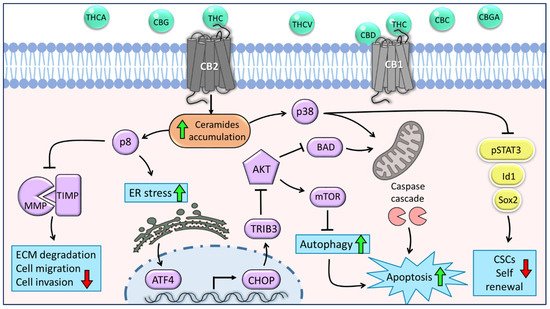Cancer is a complex family of diseases, in which a gradual change in the expression of multiple genes leads to genomic instability and cell death imbalance, resulting in the abnormal growth of cells
[1]. Although different types of cancer present with different phenotypic clinical characteristics and different genetic modifications, there are several common molecular patterns and biological capabilities acquired during malignant transformation. The hallmarks of cancer comprise six distinctive and complementary processes essential for tumor growth and survival: sustaining proliferative signaling insensitivity to growth suppressors; disproportionately greater growth over cell death; limitless replicative potential; and the induction of angiogenesis, tissue invasion, and metastasis
[2].
Cannabis sativa L. (
C. sativa) is a diecious annual herb belonging to the Cannabaceae family and has been effective in treating numerous medical conditions
[3][4][3,4]. The major utilization of cannabis is for recreational purposes. While many countries are legalizing cannabis production and use, cannabis remains the most widely used illegal drug globally
[5]. However, the medical use of this plant has been documented in the oldest Chinese pharmacopoeia pen-ts’ao ching (compiled in 100 CE but attributed to Emperor Sheng Nung, c. 2700 BCE) for pain relief, constipation, and other ailments. In India, the plant was historically used for analgesic, tranquilizing, anesthetic, antibiotic, and anti-inflammatory functions
[6][7][8][6,7,8]. Around 600 constituents have been identified in
C. sativa, among them being several classes of secondary metabolites, including dozens of flavonoids, hundreds of terpenes, and more than 160 terpenophenolic compounds known as phytocannabinoids
[9][10][11][12][9,10,11,12]. Among the most abundant phytocannabinoids are Δ9-tetrahydrocannabinol (THC), cannabidiol (CBD), and cannabigerol (CBG), which are all synthesized by female plants and stored mainly in epidermal glandular trichomes, which are densely concentrated in the inflorescence and bracts. Phytocannabinoids are produced as prenylated aromatic carboxylic acids and converted to neutral homologous forms by decarboxylation, which occurs to some extent within the living plant but mostly when catalyzed by heat following harvesting
[9][10][11][12][9,10,11,12]. Today, several cannabis preparations or synthetic compounds have been approved by health authorities worldwide (e.g., FDA or EU) and meet the same regulatory requirements of pharmaceutical drugs in terms of safety, efficacy, and consistency. These include Nabiximols, which is a whole-plant prescription cannabinoid used in the management of patients with multiple sclerosis, chronic neuropathic pain, and cancer-related pain
[13]. Another example is Dronabinol, a synthetic phytocannabinoid (THC) that is marketed as medicines in several countries and which is indicated for the treatment of anorexia and weight loss in adult patients with HIV/AIDS or cancer
[14].

